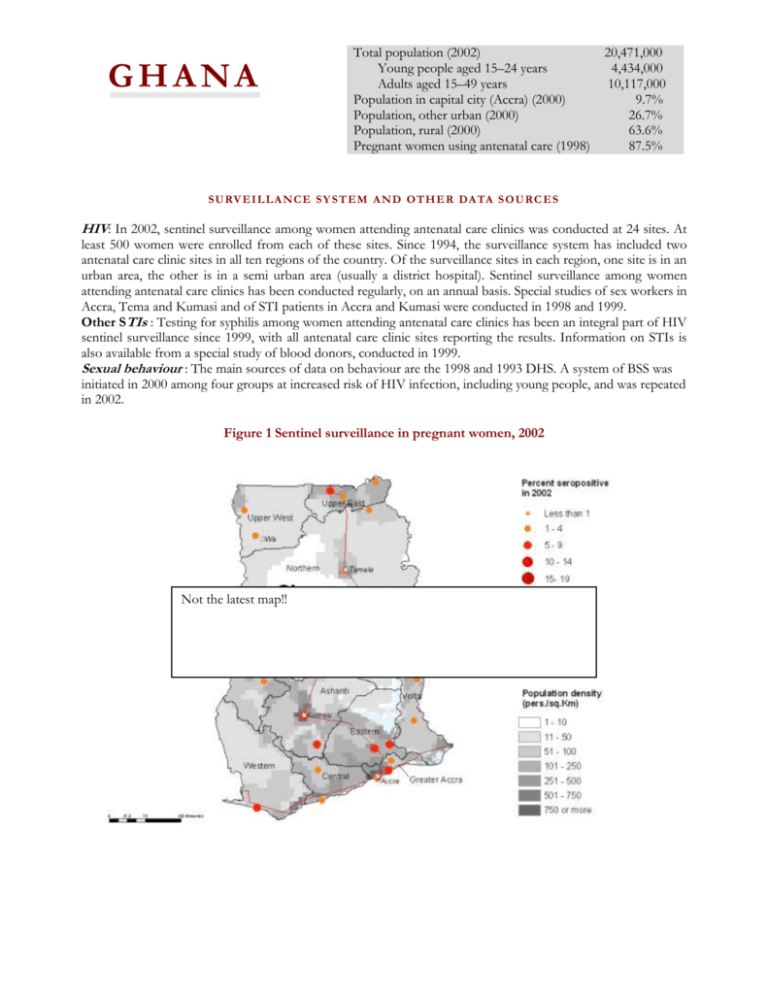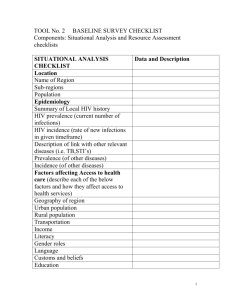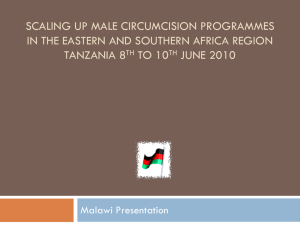
GHANA
Total population (2002)
Young people aged 15–24 years
Adults aged 15–49 years
Population in capital city (Accra) (2000)
Population, other urban (2000)
Population, rural (2000)
Pregnant women using antenatal care (1998)
20,471,000
4,434,000
10,117,000
9.7%
26.7%
63.6%
87.5%
S U RV E I L L A N C E S Y S T E M A N D OT H E R DA TA S OU RC E S
HIV: In 2002, sentinel surveillance among women attending antenatal care clinics was conducted at 24 sites. At
least 500 women were enrolled from each of these sites. Since 1994, the surveillance system has included two
antenatal care clinic sites in all ten regions of the country. Of the surveillance sites in each region, one site is in an
urban area, the other is in a semi urban area (usually a district hospital). Sentinel surveillance among women
attending antenatal care clinics has been conducted regularly, on an annual basis. Special studies of sex workers in
Accra, Tema and Kumasi and of STI patients in Accra and Kumasi were conducted in 1998 and 1999.
Other STIs : Testing for syphilis among women attending antenatal care clinics has been an integral part of HIV
sentinel surveillance since 1999, with all antenatal care clinic sites reporting the results. Information on STIs is
also available from a special study of blood donors, conducted in 1999.
Sexual behaviour : The main sources of data on behaviour are the 1998 and 1993 DHS. A system of BSS was
initiated in 2000 among four groups at increased risk of HIV infection, including young people, and was repeated
in 2002.
Figure 1 Sentinel surveillance in pregnant women, 2002
Not the latest map!!
HIV
In 2002, the median HIV prevalence among women attending antenatal care clinics at 24 sites was 3.4%. HIV
prevalence was only slightly higher in the four sites in Accra (4.1%) than in the ten regional towns (3.4%) and the
sites outside the regional towns (3.2%). HIV-1 is the predominant infecting agent (92.2% of cases), while 7.4%
of cases are dual infections with HIV-1 and HIV-2, and only 0.5% of all infections in 2002 were with HIV-2
alone. The trend in HIV prevalence from 1994 to 2002 among all antenatal care clinic sites in Ghana shows that
prevalence fluctuates between 2% and 3.5% with no clear pattern (Figure 2).
Figure 2 Trend in median HIV prevalence
among women attending antenatal care
clinics, Ghana, 1994–2002
Figure 3 Trend in median HIV prevalence
……… among women aged 15–24 years
attending antenatal care clinics, Ghana,
1994–2002
5
5
4
3
Prevalence (%)
Prevalence (%)
4
2
1
3
2
1
0
1994 1995 1995 1997 1998 1999 2000 2001 2002
0
1994 1995 1996 1997 1998 1999 2000 2001 2002
The highest HIV prevalence in Ghana was recorded in Agomanya and Atua in the Eastern Region in the late
1990s (14.9%). This has been attributed to economically-driven migration to, especially, Côte d’Ivoire following
the building of the Akosombo dam. HIV prevalence recorded at Agomanya antenatal care clinic has since
dropped to 7.0% in 2002, although it is still higher than at most sites elsewhere in Ghana. HIV prevalence is
lowest in the three regions in the northern part of Ghana, followed by the central and southern regions. The
difference in HIV prevalence between the central and southern regions is small.
In 1999, a survey of sex workers in Tema and Accra found a HIV prevalence of 74.2% among the “seater”
street-based sex workers, and 27.2% among the home-based “roamer” sex workers, findings similar to those
observed in 1997/98. In Kumasi, prevalence among sex workers was very high (82%) in 1999.
OT H E R S T I s
In 2002, the median prevalence of syphilis among women attending antenatal care clinics at all antenatal sites was
0.5% in 2002, compared with 0.2% in 1999, 0.7% in 2000 and 0.2% in 2001. A study conducted by the National
Blood Transfusion Service in 1999 showed that 3.5% of blood donors, almost all of whom were replacement
donors (family members of the blood recipient), tested positive for syphilis, indicating past or present infection.
S E X UA L B E H AV I OU R
According to the DHS of 1999, 37% of the men aged 15–49 years who had ever had sex reported having more
than one sexual partner in the last year, with 13% saying that they had had more than two partners. In the 1998
DHS, 25% of the married or cohabiting men reported having had an extra-marital or non-cohabiting partner in
the last year. In the 2000 BSS, 25% of male policemen in Accra and 29% of male miners in Obuasi reported
having had sex with non-regular partners in the past year. Three percent of policemen and 7% of the miners
reported having sex with a sex worker in the last year.
The Ghana DHS does not provide data on condom use with high-risk partners, but in 1998, 15% of men and
68% of women reported using a condom during last sex. High levels of condom use during sex with non-regular
partners were reported by policemen and male miners. In Obuasi, 51% of miners and in Accra, 61% of
policemen who reported a non-regular partner in the last year had used a condom at last sex with a non-regular
sexual partner.
Among sex workers, 95% in Accra and 73% in Obuasi reported the use of a condom at last sex with a paying
client. The proportion of sex workers who reported the use of condoms during every sex act with clients was
88% and 44% in Accra and Obuasi respectively.
YO U N G P E OP L E
HIV : Apart from a dip in 1999, the trend in HIV prevalence among pregnant women aged 15–24 years shows
little change, with prevalence remaining at about 3% (Figure 3). In 2002, the median HIV prevalence among
young pregnant women in Accra was 4.1%, while in other urban areas it was 3.4% and outside major urban
clinics it was 3.2%. For all 24 sites combined, the median was 3.4%.
Age at first sex : According to the 1998 DHS, the median age at first sex was 18.3 years for young women and
20.5 years for young men. In 1993, median age at first sex was reported to be 17.0 years for women and 18.6
years for men.
Premarital sex : The median age at first marriage in 1998 among young women aged 15–24 years was 20 years,
while less than half of men were still unmarried by the age of 25 years. Premarital sex is more common among
men than women, and a substantial decline occurred in the 1990s (Figure 4).
Condom use : According to the 1998 DHS, , 22% of young women and 40% of young men who reported
having premarital sex in the last year said that they had used a condom at last premarital sex .
Figure 4 Young people aged 15–24 years reporting premarital sex in the last year, Ghana, 1993 and 1998
49
46
50
40
1993
1998
31
24
%
30
20
10
0
Young men
Young women
C O N C L U S I O N S A N D R E C O M M E N DA T I O N S
HIV prevalence among women attending antenatal care clinics in Ghana has remained fairly constant,
between 3% and 4%, for the last five years. Using the three strata — capital city, major urban, and outside
major urban areas — the weighted median prevalence for all pregnant women in 1998 is 3.3%. Nationally,
HIV prevalence is likely to be somewhat lower as rural populations are underrepresented in the surveillance
system. Notable is the lack of difference between Accra and other urban areas, but a few studies in sex
workers have found very high prevalence.
The main changes observed in sexual behaviour are an increase in age at first sex, a reduction in the
prevalence of premarital sex and an increase in condom use, although overall condom use remains low,
except in commercial sex.
To strengthen surveillance, it can be recommended that:
HIV : Antenatal care clinic-based surveillance is operating well and needs to be continued. Inclusion of a
number of truly rural sites should be considered.
Other STIs : Surveillance of syphilis among women attending antenatal care clinics needs to be
continued and complemented with regular surveillance at a few selected sites in urban areas.
Sexual behaviour : The use of DHS surveys to monitor trends in sexual behaviour in the general
population and in young people needs to continue and to be complemented with regular surveys carried
out in populations at a higher risk of HIV infection, as has already been initiated.
REFERENCES
[1] MEASURE, National AIDS Control Programme, National AIDS Commission. AIDS in Africa during the nineties: Ghana. A review and
analysis of surveys and research studies. Carolina Population Center, University of North Carolina at Chapel Hill, 2003; and Ghana Statistical
Service and Macro International Inc., Ghana Demographic and Health Survey 1998. Calverton, Maryland, 1999.
[2] National AIDS Control Programme: HIV Sentinel Surveillance, Disease Control Unit., Ministry of Health, Accra, Ghana. Reports for
1998 until 2002.
[3] Pepin J, Sobela F, Deslandes S et al. Etiology of urethral discharge in West Africa: the role of Mycoplasma genitalium and Trichomonas
vaginalis. Bulletin of the WHO, 2001, 79: 188–126.
[4] Research International and Family Health International, in collaboration with the National AIDS Control Program of the Ministry of
Health, Ghana. Behavioral Surveillance Survey, Ghana 2000.
[5] Sauve N, Dzokoto A, Opare B et al. The price of development: HIV infection in a semiurban community of Ghana. Journal of AIDS,
2002, 20: 402–408.
[6] UNICEF. UNICEF Global Database; Antenatal Care (http://www.childinfo.org/eddb/antenatal/database1.htm). Accessed June
2003.
[7] United Nations Population Division. World population prospects: the 2002 revision. (http://esa.un.org/unpp/). Accessed June 2003.
[8] WHO/AFRO database on HIV surveillance. Accessed June 2003.
[9] WHO/AFRO. HIV surveillance report for Africa, 2000. November 2001
(http://www.afro.who.int/aids/surveillance/resources/hiv_surveillance_report_2000.pdf).


![[CLICK HERE AND TYPE TITLE]](http://s3.studylib.net/store/data/007215999_1-000ccbdd38bb3e465714adeb5f197f4f-300x300.png)


